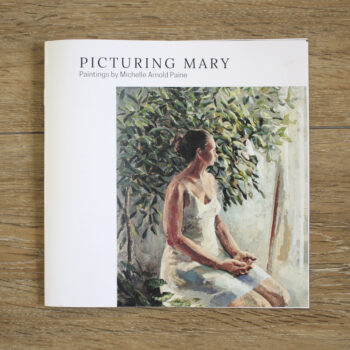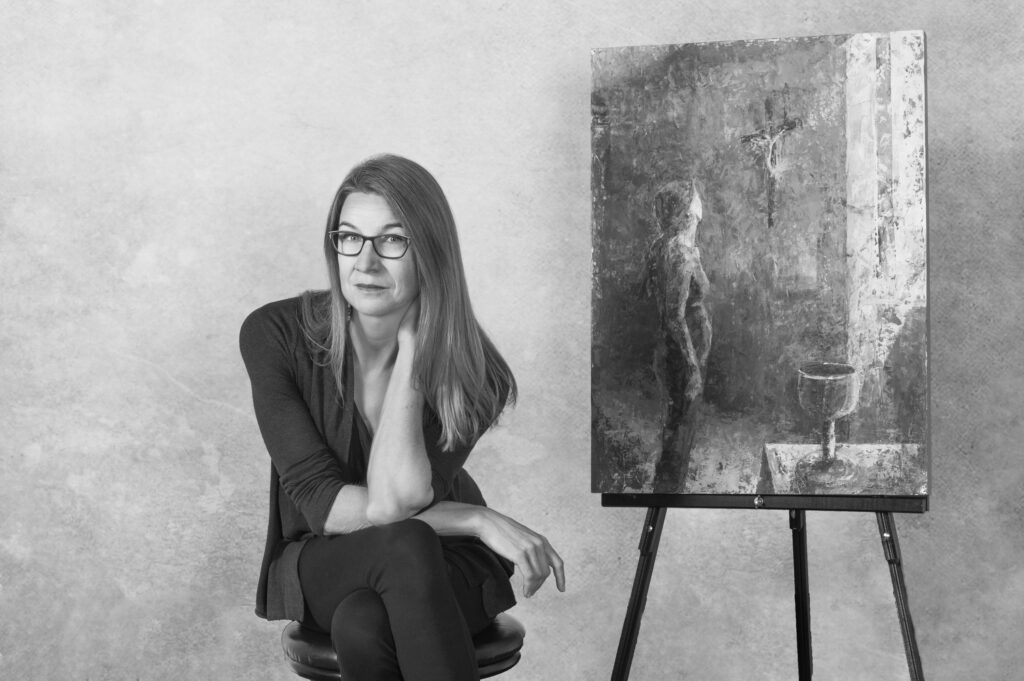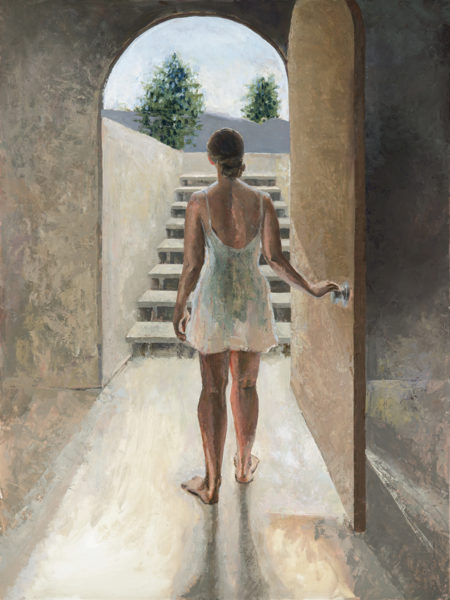
“Ascent/Descent”, Oil on Panel, 48″ x 36″ ©Michelle Arnold Paine
Angels Ascending and Descending
Ascent/Descent is a contemporary interpretation of the Virgin Mary as Jacob’s Ladder. This reading of Genesis 28 views Jacob’s vision of the stairway ascending to heaven as a pre-figuration of the Virgin Birth. Mary was the fulfillment of the LORD’s promise in this passage “I am with you and will watch over you wherever you go, and I will bring you back to this land. I will not leave you until I have done what I have promised you.” Through Jesus’ salvation (brought forth by Mary) we are able to ascend to heaven, and through Mary, Jesus descended to earth. Mary was the vehicle, the connection between heaven and earth which allowed salvation to come.
Icon Inspiration
I first encountered Jacob’s Ladder as a type of the Virgin Mary in an icon from St. Catherine’s monastery on Mt. Sinai. I initially found the image in Hans Belting’s “Likeness and Presence” while researching for a Byzantine history class in college. The paper I wrote as a result delved deep into the iconographic program of the icon’s content. In this icon, narrative scenes from the Hebrew Bible surround the Virgin Mary, establishing an overall theme of Mary’s role in salvation history. Each of these narrative scenes demonstrates a different Old Testament story which pre-figures Christ’s birth. Investigating this icon changed the way I looked at scripture. Seeing these Old Testament miracles as signs of the great miracle to come in Christ led me to a new way of reading the Bible.
More than twenty years ago I began to investigate these pre-figurations of Mary and the coming of Christ. They continue to find a place in my artworks. The medieval hymn “Mary the Dawn”, which I’ve written about elsewhere, has provided a great deal of my material and inspiration.
What is “Prefiguration”?
Prefiguration was an exegetical method of establishing Old Testament prototypes for New Testament events. Basil the Great (329-379 AD) invoked types as a guide for conduct, saying: “the lives of saintly men, recorded and handed down to us, lie before us like living images of God’s government, for our imitation.” (Gary Vikan. Typology. Oxford Dictionary of Byazantium 2133). In icons this is literally true: the saints are before the viewer for contemplation and imitation. They are examples of the way that Christ’s coming was foretold and expected from the Creation.
Studying art history in Italy, I became fascinated with the way medieval and Renaissance artists such as Lorenzo Maitani, Giotto, Lorenzo Ghiberti, Masaccio and Fra Angelico crossed boundaries of space and time in their paintings to communicate the truths of prophecy and fulfillment in the biblical texts. I have long desired to explore those themes in my contemporary stylistic time and place.
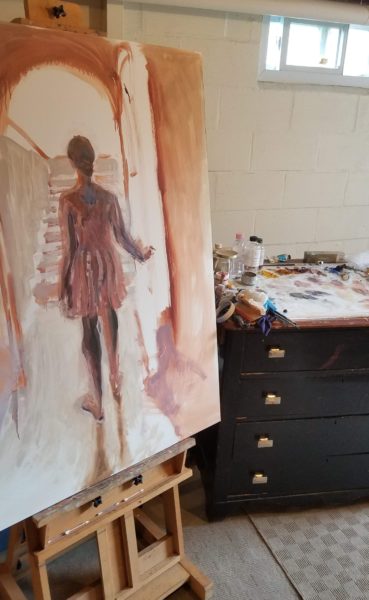
Ascent/Descent in Progress in Studio, ©Michelle Arnold Paine 2021
Painting in Process: Form and Content
Continuing the series of Marian paintings which I developed for my Advent Artist-in-Residence at Valparaiso University years ago has been a slow process. I continue to be fascinated by Mary who makes the choice to open the door to heaven which had been closed by Eve. Since graduate school I have explored the theme of thresholds and open doors. I have found some success in creating the mysterious spiritual atmosphere of this moment in the medium of monotype.
Over the last several years a friend has begun modeling occasionally for my paintings. The modeling time has become an opportunity for fellowship and mutual encouragement. For this piece, I wanted to use the door from my basement studio to the bulkhead stairs leading outside. I was interested in this element partly because the light pouring in from above is very dramatic. When we were brainstorming how to set up a relevant image, she said “Let’s make it Jacob’s Ladder”. She understood the connection between Mary and Jacob’s Ladder and is familiar with my strong use of medieval and Biblical metaphors and texts in my paintings.
So the bulkhead stairs out of my dungeon-like basement studio becomes the stairway to heaven.
Mary as Jacob’s Ladder
In Orthodox tradition, Jacob’s ladder is a symbol of the Virgin herself, through whom God descended to earth. Her son Jesus, both human and divine, is both humanity’s father and brother. As a result of Christ’s descent to earth via the Virgin birth, Christians may ascend to heaven. The Orthodox church reads the Old Testament story of Jacob’s ladder each year on the feast of the Birth of the Virgin Mary (September 8), the feast of the Annunciation (March 25), and on the feast of her Dormition or Assumption (August 15).
Mary as Jacob’s Ladder in St. John of Damascus
In one of his sermons on the Virgin’s Dormition, John of Damascus explains the relationship of Mary to Jacob’s Ladder. Considered a “Doctor of the Church” in the Catholic church for his great contributions to theology, John of Damascus was a monk who lived in the 8th century. He was a primary defender of the use of images in worship in the time of Iconoclasm, when many Christians were destroying art in churches out of concerns about idolagry. Much of his writing demonstrates how God’s redemptive narrative culminates and centers on the Incarnation. In this passage he shows how Jacob’s Ladder was a prophecy of salvation through Christ:
‘Is it not evident to every one that it [Jacob’s ladder] prefigured thee, and is not the type easily recognized? Just as Jacob saw the ladder bringing together heaven and earth, and on it angels coming down and going up, and the truly strong and invulnerable God wrestling mystically with himself, so art thou placed between us, and art become the ladder of God’s intercourse, with us, of Him who took upon Himself our weakness, uniting us to Himself, and enabling man to see God. Though hast brought together what was parted. Hence angels descended to Him, ministering to Him as their God and Lord, and men, adopting the life of angels, are carried up to heaven. (John of Damascus. Par. 161-162)

Studies of feet, Pencil on Paper 2019 ©Michelle Arnold Paine
Visual Research
I completed the thematic research for the content of this painting many years ago. However, as the painting progressed I encountered visual, technical problems of representation. I completed many supporting drawings in order to be able to represent my vision with skill and accuracy. For example, I needed to investigate aspects of anatomy and perspective to complement the thematic research in order for the idea to conform to my post-Renaissance visual language. Using the full figure in large scale, I found the hands and feet challenging, so I dug out anatomy books to study hands and feet.
I began to find the mathematical, uniform, nature of the stairway tedious. In order to understand the way the measurements shifted as the stairs move away from the viewer, I created a constructive perspective drawing.
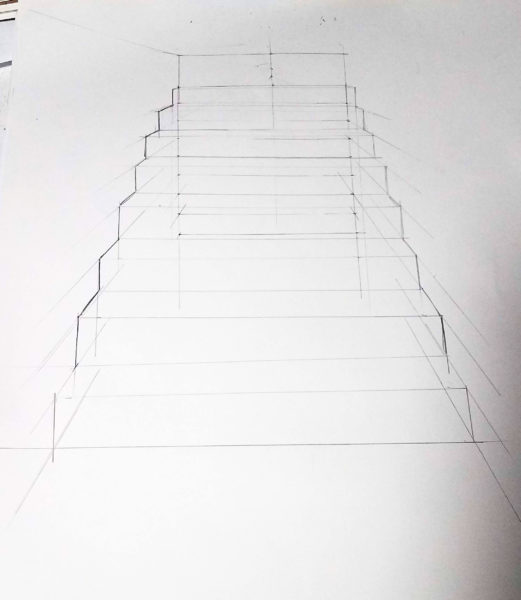
Perspective Study for “Ascent/Descent”, Pencil on Paper ©Michelle Arnold Paine
With the help of these drawings I was able to construct my contemporary vision of Mary as Jacob’s Ladder. My aim with this series of paintings is to re-introduce these Marian images to us with fresh perspective. “Surely this place is the gate of heaven” Jacob says in Genesis 28. Setting this scene in a contemporary space, using my basement stairs as the setting, becomes a reminder of the Incarnation, a reminder that God comes to encounter us in any time or place, in the most humble of places.
I have several more of these paintings in progress in my studio. Enter your email address below to be notified when they are complete!


